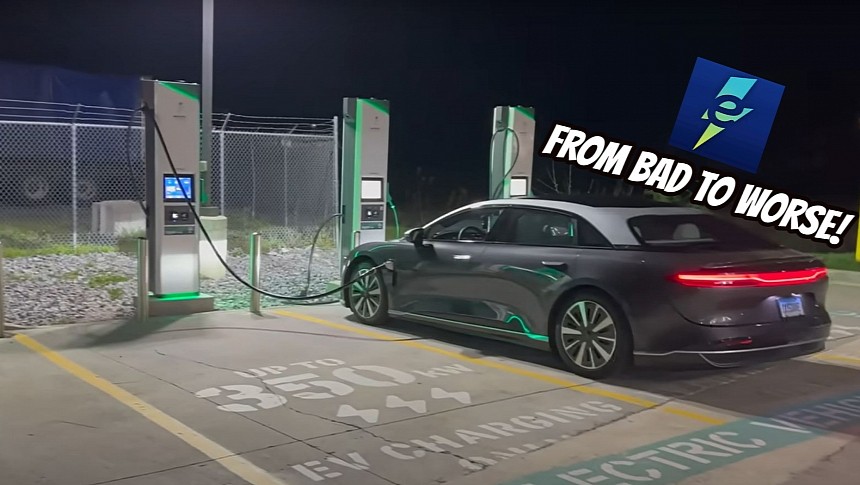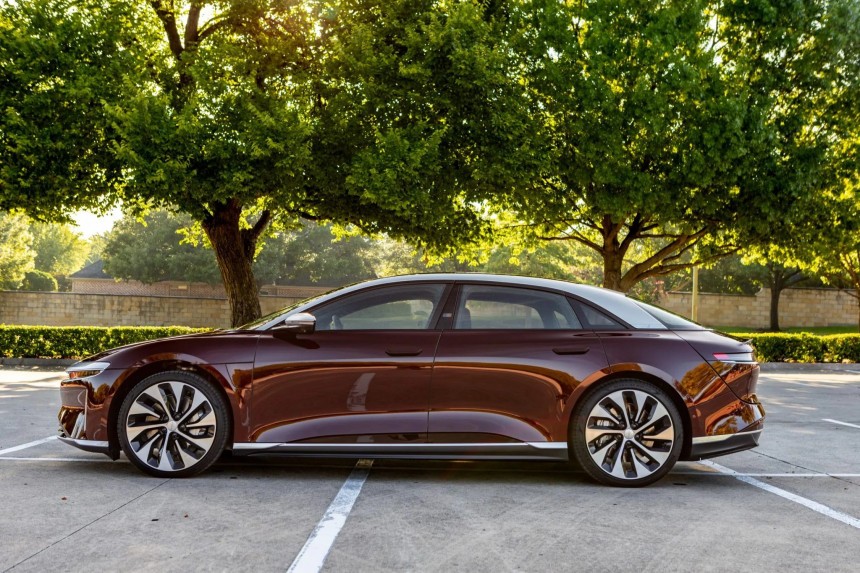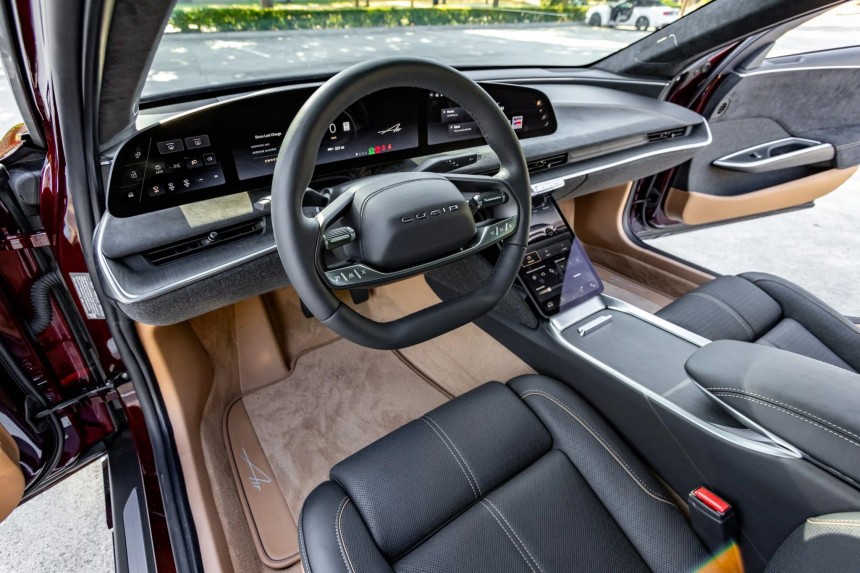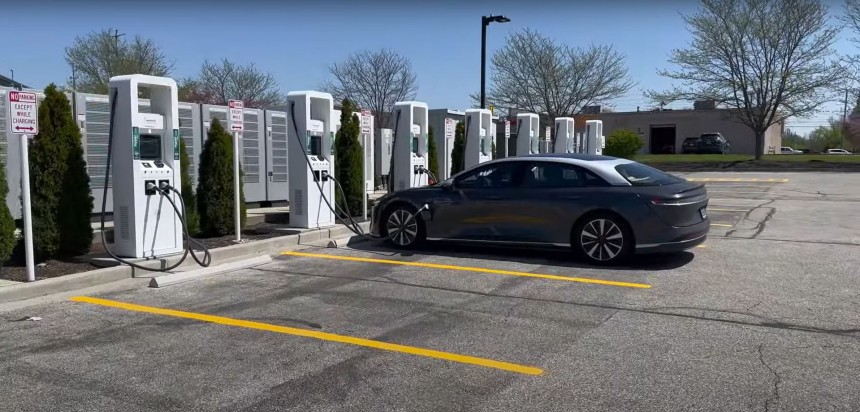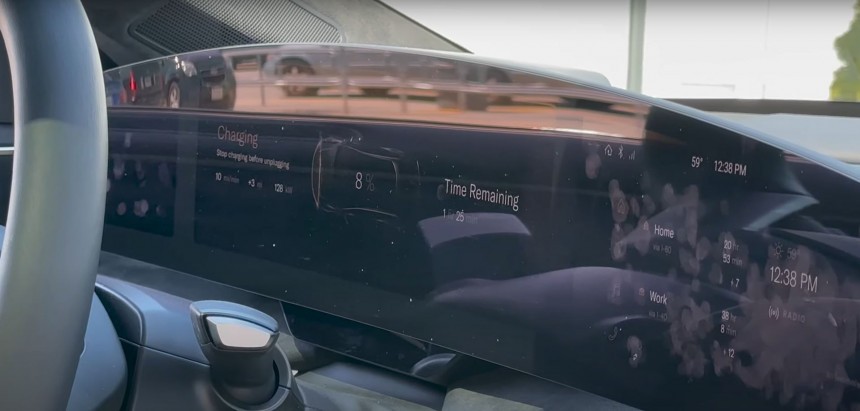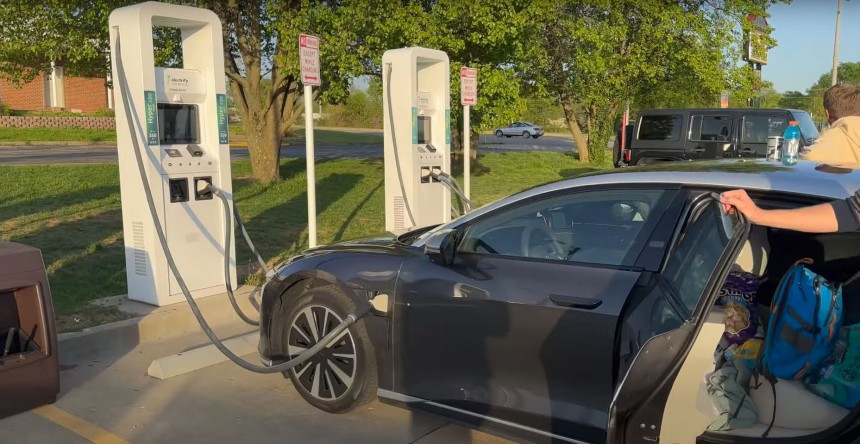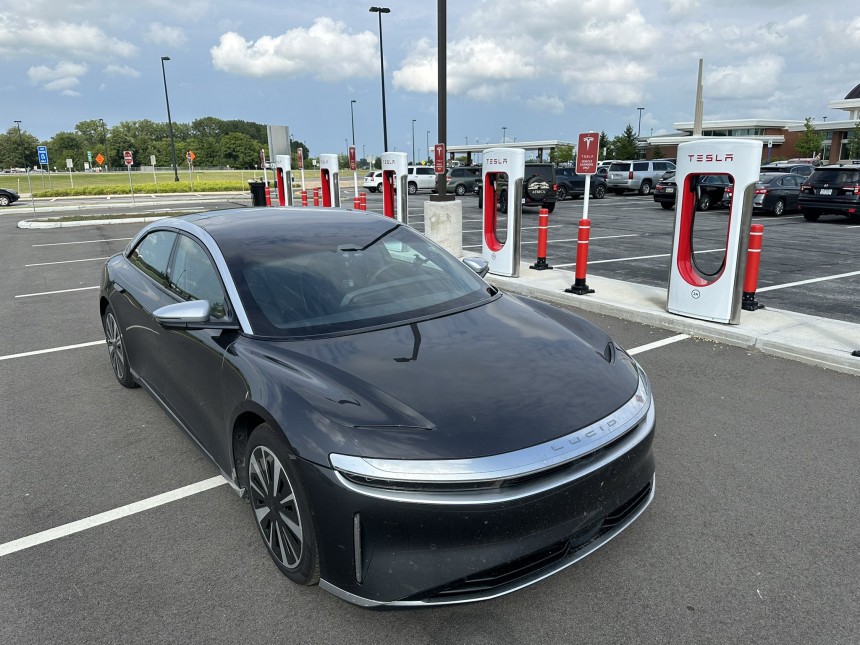It has been widely known for some time now that high-power charging networks are essential to the transition to zero-tailpipe emission powertrains. Electric vehicles (EVs) cannot succeed in replacing internal combustion engine-powered cars without them. But here's yet another proof that no matter how good your EV might be, it will eventually make you think about filling up with gas again. Or, in a blow to some auto brands, it might force you to reconsider the make and model of your EV.
Imagine you are getting ready for a 2,000-mile road trip with one of the world's most awesome sedans – the Lucid Air Grand Touring. It's fast, spacious, comfortable, filled with the coolest amenities, and has enough range to make you confident about venturing onto the open roads.
The car is basically a luxobarge dedicated to people who love comfort, want cool stuff available at their fingertips, and don't want to own a German-made automobile.
With 800 hp, a 112-kWh battery good for an EPA-rated 520 mi on a full charge, and the 900V architecture enabling impressive charging speeds (adding around 200 mi of range in under 20 minutes), this dual-motor all-wheel-drive sedan has a starting cost of $138,000 and is trying to sway you away from things like the Tesla Model S, Mercedes-Benz EQS, or the BMW i7.
The Saudi-owned but US-based brand even offers its customers one or two years of complimentary charging through a partnership with Electrify America. And that's where things start to "surge" – in the wrong direction.
Since the Lucid Air Grand Touring can take advantage of the best DC fast chargers out there (350-kW stalls), the man wouldn't have had to spend more than 30 or 40 minutes plugged in. Besides that, the vehicle tells the driver when and where they should recharge for the most efficient trip possible via the infotainment system. As such, a road trip like this wouldn't theoretically require any serious planning beforehand. All he had to do was follow the navigation.
But you already know things went south because you read the title of this article.
Let's rewind for a bit.
Around three months ago, we were telling you about an EV Cannonball record attempt that didn't work out. The vehicle used for that fast drive across the United States, from New York City's Red Ball Garage to the Portofino Hotel & Marina in California, was the exact same one as the unit chosen for this "casual" trip to Connecticut. We're putting quotation marks on "casual" because traveling with an EV is still a pain for most drivers.
To summarize, the attempt remained an attempt. The team, although well prepared, could not establish a new EV Cannonball record. Whilst some may be inclined to blame the car, traffic, or law enforcement for slowing down the crew and making them fail, the main reason was that the charging network was unable to work correctly in most cases. They even accounted for possible damaged stalls, but it wasn't enough.
Now, let's return to the Colorado to Connecticut trip.
He plugged in the car at under 10% state of charge (SoC) and immediately saw that the rate at which the EV was pulling electrons from the grid kept oscillating. The charging speed changed every second or even faster. It stabilized for a few minutes, starting at 22% SoC, and returned to this erratic behavior after 35% SoC.
This issue isn't unique to Lucid vehicles, but it seems to affect all-electric cars with battery packs with a voltage of at least 800V. For example, Hyundai Ioniq 5 and Kia EV6 owners have reported similar issues online. Even Genesis owners experienced the same outcome because all these South Korean vehicles are built on the E-GMP platform.
But there are other models affected by the rapidly oscillating charging speed. Porsche Taycan, for example, is also experiencing similar problems. However, since the vehicle operates in a different voltage range than the Lucid and the Hyundai models, it's far less affected by the phenomenon known as "Signet Surge."
Some people think it's a software-related problem; others blame the stalls' power modules. However, a couple of things are evident at the time of writing.
One, nobody knows how to fix the Signet Surge issue without replacing all the stalls with new ones or overhauling the software suite.
Two, despite reports of having to replace their fried Integrated Charging Control Unit (ICCU) under warranty from Hyundai owners, it's unclear if the rapidly oscillating charging speed can lead to severe problems or costly battery management system (BMS) repairs.
All that's known is that vehicles capable of charging very fast may be susceptible to the Signet Surge, thus having to spend more time plugged in.
Three, some EVs may not be able to charge as fast as possible at some Electrify America stalls.
Four, the reputation of Electrify America has suffered so badly that car buyers have coined the term "non-Tesla EV." The Supercharger network's reliability has others regretting their choices.
"The Lucid is great, EA and Signet are not. So sad actually. This monster road tripper is being hampered by this ridiculous EA partner of theirs. This is really serious," said the driver.
Fortunately, on the last leg of the journey, he found a newer Electrify America station where ABB-made stalls worked as expected and dispensed electrons at a swift rate – only 82 minutes were needed for a 7% to 100% charge. Keep in mind that most EVs slow their charging rate considerably after the 80% threshold.
Now, it's clear that Electrify America has a lot of work to do. Besides the Signet Surge, people also complain about slower-than-advertised charging speeds. That's bound to make road-trippers upset.
The problem with non-Tesla EVs today is that they don't enjoy a comprehensive and reliable charging network. But with the numerous incentives coming from the federal government, the interest of EV makers to provide their customers with reliable DC fast chargers, the fossil fuel giants entering the EV charging space, and the industry-wide switch to Tesla's charging port…
Things are certainly looking interesting for consumers and, sadly, bleak for Electrify America.
Finally, this article must be perceived as something other than a dig at Electrify America. I firmly believe this Dieselgate-born charging network will become a strong competitor for Tesla's Supercharger. Still, it cannot reach its potential by estranging prospective customers, especially those with free charging deals with their vehicle acquisition!
Someone buying an EV for the first time and expecting to live with it like with a gas-powered car may experience disappointment and frustration, which will only alienate them from believing in a zero-tailpipe emission future.
It's time to get together, Electrify America (and VW)! BMW, General Motors, Honda, Hyundai, Kia, Mercedes-Benz, and Stellantis are coming for you through their Ionity-like alliance for the US, while Tesla is out there making people jealous they didn't buy a NACS-equipped car.
The car is basically a luxobarge dedicated to people who love comfort, want cool stuff available at their fingertips, and don't want to own a German-made automobile.
With 800 hp, a 112-kWh battery good for an EPA-rated 520 mi on a full charge, and the 900V architecture enabling impressive charging speeds (adding around 200 mi of range in under 20 minutes), this dual-motor all-wheel-drive sedan has a starting cost of $138,000 and is trying to sway you away from things like the Tesla Model S, Mercedes-Benz EQS, or the BMW i7.
Owning an (expensive) EV in the US? Not as electrifying as one may think
A YouTuber from the Out of Spec crew decided to embark on a 2,000-mile journey from Colorado to Connecticut. His Lucid chosen for this adventure was nearly perfect. The vehicle would have theoretically required five or six quick stops at the most to recharge the generous energy storage unit.Since the Lucid Air Grand Touring can take advantage of the best DC fast chargers out there (350-kW stalls), the man wouldn't have had to spend more than 30 or 40 minutes plugged in. Besides that, the vehicle tells the driver when and where they should recharge for the most efficient trip possible via the infotainment system. As such, a road trip like this wouldn't theoretically require any serious planning beforehand. All he had to do was follow the navigation.
But you already know things went south because you read the title of this article.
Let's rewind for a bit.
To summarize, the attempt remained an attempt. The team, although well prepared, could not establish a new EV Cannonball record. Whilst some may be inclined to blame the car, traffic, or law enforcement for slowing down the crew and making them fail, the main reason was that the charging network was unable to work correctly in most cases. They even accounted for possible damaged stalls, but it wasn't enough.
Now, let's return to the Colorado to Connecticut trip.
Electrify America's chance at redeeming itself
The same very capable Lucid Air Grand Touring got put through a somewhat shorter trip than the coast-to-coast one. However, the owner figured out right after starting the journey that it would be unnecessarily lengthy.This issue isn't unique to Lucid vehicles, but it seems to affect all-electric cars with battery packs with a voltage of at least 800V. For example, Hyundai Ioniq 5 and Kia EV6 owners have reported similar issues online. Even Genesis owners experienced the same outcome because all these South Korean vehicles are built on the E-GMP platform.
But there are other models affected by the rapidly oscillating charging speed. Porsche Taycan, for example, is also experiencing similar problems. However, since the vehicle operates in a different voltage range than the Lucid and the Hyundai models, it's far less affected by the phenomenon known as "Signet Surge."
Figuring it out
Nobody knows exactly what causes the charging rate to spike and drop so fast and often, but it seems to affect older Electrify America stalls made by SK Signet. Hence the nickname given to this phenomenon. It's also possible that some ABB chargers may have rendered similar outcomes.Some people think it's a software-related problem; others blame the stalls' power modules. However, a couple of things are evident at the time of writing.
One, nobody knows how to fix the Signet Surge issue without replacing all the stalls with new ones or overhauling the software suite.
All that's known is that vehicles capable of charging very fast may be susceptible to the Signet Surge, thus having to spend more time plugged in.
Three, some EVs may not be able to charge as fast as possible at some Electrify America stalls.
Four, the reputation of Electrify America has suffered so badly that car buyers have coined the term "non-Tesla EV." The Supercharger network's reliability has others regretting their choices.
Moving on
The Lucid Air Grand Touring owner continued his trip and experienced the same phenomenon at other charging stations.Fortunately, on the last leg of the journey, he found a newer Electrify America station where ABB-made stalls worked as expected and dispensed electrons at a swift rate – only 82 minutes were needed for a 7% to 100% charge. Keep in mind that most EVs slow their charging rate considerably after the 80% threshold.
Now, it's clear that Electrify America has a lot of work to do. Besides the Signet Surge, people also complain about slower-than-advertised charging speeds. That's bound to make road-trippers upset.
The problem with non-Tesla EVs today is that they don't enjoy a comprehensive and reliable charging network. But with the numerous incentives coming from the federal government, the interest of EV makers to provide their customers with reliable DC fast chargers, the fossil fuel giants entering the EV charging space, and the industry-wide switch to Tesla's charging port…
Finally, this article must be perceived as something other than a dig at Electrify America. I firmly believe this Dieselgate-born charging network will become a strong competitor for Tesla's Supercharger. Still, it cannot reach its potential by estranging prospective customers, especially those with free charging deals with their vehicle acquisition!
Someone buying an EV for the first time and expecting to live with it like with a gas-powered car may experience disappointment and frustration, which will only alienate them from believing in a zero-tailpipe emission future.
It's time to get together, Electrify America (and VW)! BMW, General Motors, Honda, Hyundai, Kia, Mercedes-Benz, and Stellantis are coming for you through their Ionity-like alliance for the US, while Tesla is out there making people jealous they didn't buy a NACS-equipped car.
Colorado to Connecticut Lucid Air Road Trip @RateYourCharge thread #1. Not starting off good here AT ALL. Plug and charge failed 2 times, signet surge kicked in and I invented a dance called the “Signet Surge” with new words to Old McDonald that you will have to see in my road… pic.twitter.com/pDG53aggwv
— Out Of Spec Dave (@OutofSpecDave) July 22, 2023
